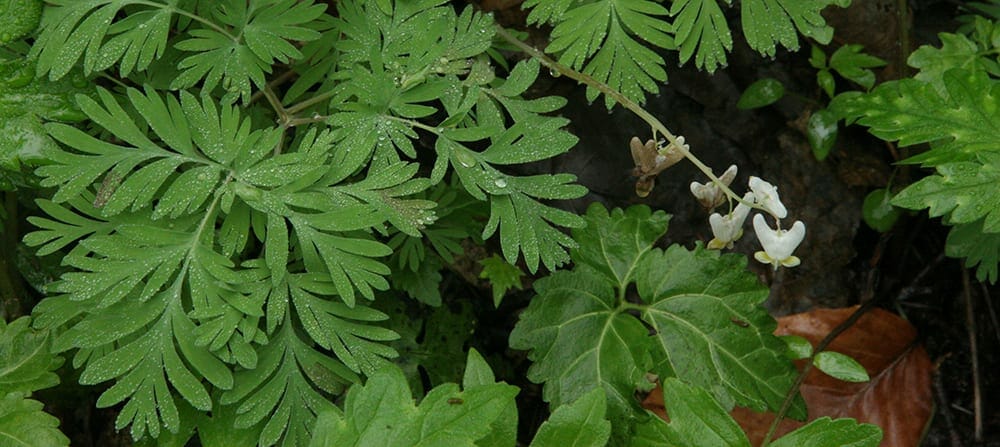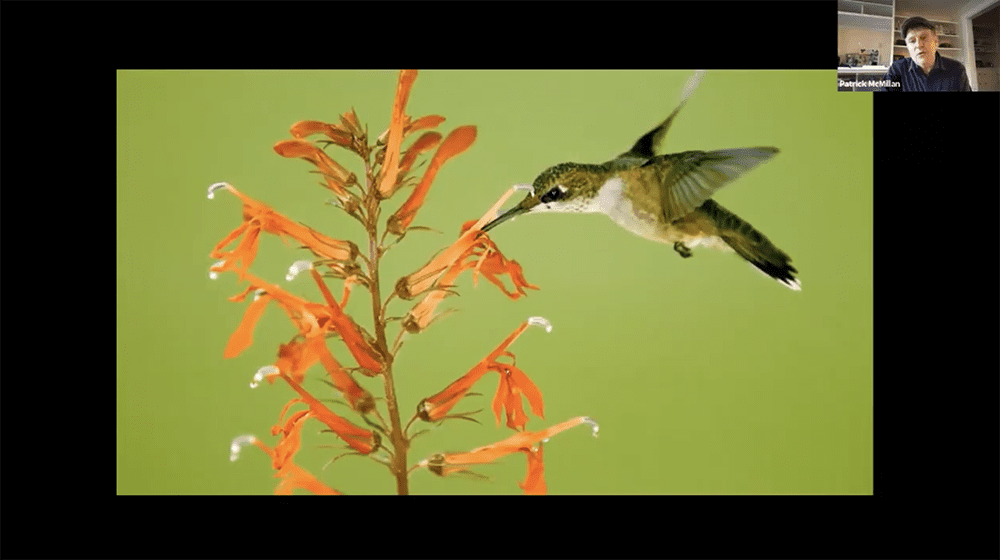
Dutchman's breeches (Dicentra cucullaria), with crinkleroot (Cardamine diphylla) and more, Shirley Miller Wildflower Trail.
Symposium Goes on in Pandemic
Our first virtual Symposium is a wrap and we hope you had a chance to enjoy it as much as we did. We partnered with Georgia Audubon to bring four speakers across two days to educate us on how Georgia’s native plants support our native wildlife – from the ground up!
We were particularly excited to strengthen our partnership with Georgia Audubon through this event. While we have worked with them before with our plant sales, collaborating on education events is, we hope, the first of many such efforts. Our messages, while important alone, are even more significant together. Members from both organizations participated – 375 total attendees across both days.

During the symposium, Patrick McMillan described the unique aspects of hummingbirds and the flowers that they visit, including cardinal flower (Lobelia cardinalis).
Credit for the program goes to Leslie Edwards and Marc LaFountain; they identified the theme and the four speakers who would support that message. Plants are the building blocks of our local ecosystems and native plants are the most supportive blocks of all. From woodlands, to wetlands, to grasslands … Georgia’s insects, birds, and critters of all types depend on their relationships with native plants and places. These relationships include the food that wildlife eat (pollen, nectar, foliage, fruits), the ecosystems that native plants create, and the habitat that they foster. While non-native plants may contribute in part, the regionally appropriate native plants contribute far more in the space that they reside, allowing us to give back to Georgia wildlife substantially in our landscapes.
We hope you are inspired to add more native plants to your landscape in support of wildlife. For those of you who attended, you should have gotten an email with a list of small nurseries offering a discount to attendees. Visit them in March as you’re adding plants to your landscape, and as Patrick McMillan said, “Fill your garden with life!”
Volunteer Opportunities
Lori Conway

A new GNPS partnership provides multiple opportunities for volunteers to guide the work of the next generation of native plant enthusiasts.
As GNPS changes and grows, our volunteer needs are likewise changing and growing. We are in the process of updating the Volunteer section of our website. Two new opportunities are described below. If any of our restoration sites or chapters have specific volunteer needs that they would like to highlight, please write those up for inclusion on the website or newsletter. We would like to make this a monthly column.
State Scholarship Committee Members Needed
Last year, the GNPS Board of Directors earmarked funds to award two annual scholarships for the State Botanical Garden’s Native Plant Certificate Program, one for a resident of the Piedmont and one for a resident of the Coastal Plain. We are extremely fortunate that SBG is willing to handle many of the administrative duties around this scholarship, but we need a state scholarship committee to review applications and select the recipients. Please contact volunteer@gnps.org, if you would like to help implement this exciting opportunity to grow the next generation of native plant lovers and conservationists.
Atlanta Area Opportunity – Assist Eagle Scouts in Brookhaven
Murphey Candler Park (MCP) is a 135-acre multi-use park located at 1551 West Nancy Creek Drive in northern DeKalb County and is the largest park in the City of Brookhaven. The Murphey Candler Park Conservancy is a wonderful group of neighbors and citizens of the park who work with the Brookhaven government and other groups to preserve and care for the park. The park contains a large lake, natural habitat, wetlands and nature trails and needs constant support to keep its natural beauty. Recently, Steve Peters, a 25-year neighbor of MCP, spearheaded an initiative whereby local Scouts seeking their Eagle Scout badge each adopt a section of the nature trail that winds around the lake. Their tasks are to identify the native plants to be preserved in their trail section along with the invasive plants that need to be removed. The Scout then leads their troop members in the restoration of their section. GNPS is partnering with Mr. Peters to help MCP with native plant identification. You need not be a current expert in native plant ID, just a willingness to get involved and learn along the way. MCP is encouraging the participating Scouts' families to join GNPS and has included our logo on the temporary signage along each trail section in progress. What a great partnership opportunity for us! Please contact volunteer@gnps.org to join the fun.
Newsletter Content
Our symposium emphasized the connections between native plants and native wildlife. There couldn't be a better time to start a new monthly feature that picks up the theme as Ellen Honeycutt does below in the Species Spotlight. If you have some expertise in native wildlife, including insects, native mammmals, reptiles, amphibians, and birds, and if you are interested in starting a new feature that emphasizes their relationships with native plants, contact us at nativescape@gnps.org.
Species Spotlight: Red-Spotted Purple Butterfly
Ellen Honeycutt
Often we admire plants for their beauty, and native plants are no exception in that department. Scratch that beautiful surface a bit and you’ll find another quality to using native plants — that is their ability to support wildlife such as the red-spotted purple butterfly (Limenitis arthemis). Often mistaken for one of our dark swallowtails, this dark blue butterfly can be found basking on the ground where it takes nourishment primarily from nutrients found in moist soil, fermenting fruit, tree sap, or even dung. They only occasionally visit flowers.
Their larvae, however, feed exclusively on plants and the caterpillars can be found on black cherry (Prunus serotina) and other cherries/plums, hawthorns (Crataegus sp.), willow (Salix sp.), serviceberry (Amelanchier sp.), black oak (Quercus velutina), and a few other native hardwoods. The olive green/brown caterpillars are interesting to point out to children while explaining that their resemblance to bird droppings helps them to escape detection by predators!
Add life to your garden this year by increasing the number of host plants for native butterflies and moths. If you have a small garden, here is a list of plants that support the highest number of species.
|